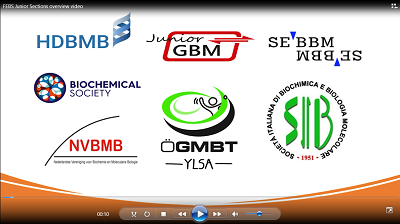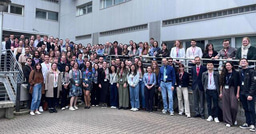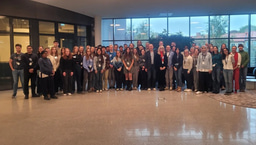Setting up Junior Sections of FEBS Constituent Societies


and visit the FEBS Junior Section Room for more posts and
videos on their national Junior Sections.
What is a Junior Section?
Some Societies have a section or group dedicated to students and young researchers and, fully or partly, run by them. The definition of a young member varies, and can include undergraduate and Master students, PhD students, and postdoctoral researchers, or might be defined by relative career stage or age (e.g., up to ten years after gaining a postgraduate qualification, or under 35 years old).
The exact format and operation of the Junior Section also varies but they might have (some of) these characteristics:
- a structure (to be decided by each Society)
- recognition and representation within the Society (with effective communication channels)
- assistance (this can take different forms and will need regular review, but it is essential)
- aims and objectives (within the Society’s aims but more specific to students and young researchers)
- a degree of independence (again, within the Society’s scope, but able to plan and decide for themselves)
- an identifiable membership (know who they are and how to reach them)
- access to funds (a designated budget or covering agreed costs)
Why have a Junior Section at all?
There are many reasons. If representing all members is part of the Society’s aims, then having a Junior Section might help to better capture the voice and meet the needs of younger members. Having their own section or group that represents them, where they can run events and maybe also contribute to shaping the main Society, might make students and young researchers more likely to join the Society. Involved and motivated young members are also more likely to support and run the Society in the future.
For young members, being able to supplement their training with activities designed by them, develop research networks, and start collaborations are some of the benefits of being part of a Junior Section. Reaching undergraduate and Master students to support their informed decision to move into the life sciences, and assist them with a research component of their studies (e.g., by helping them find internships), is also positive. Learning about career pathways outside academia, through career events and contacts outside their regular circle, can also be helpful to some young researchers. Importantly, Junior Sections and other networks are an opportunity to develop professionally, try and fail safely, learn from their peers, and develop or strengthen a collaborative mindset among young researchers. It also allows them to grow their support networks and circle of friends.
Who has a Junior Section already?
Junior Sections are… young, and not all Societies have one. Germany’s Junior-GBM was established in 2011, ÖGMBT’s Young Life Scientists Austria (YLSA) was founded in 2016, and the UK-based Biochemical Society set up an Early Career Advisory Panel in 2018. Italy’s SIB Sezione Giovani, the Netherlands’ Young NVBMB, and Croatia’s HDBMB Young Scientists’ Forum were created in 2020. Spain’s SEBBM has had ‘junior consuls’ for a while but only started to consolidate their Junior Section in 2021.
How big are they?
Generally small, but growing. The key message here is that to start a Junior Section you do not need to have that many active young members. However, supporting those volunteers is essential for the Junior Section to succeed.
Half of ÖGMBT’s 1200 members are young, but YLSA only has 15 formal volunteers. Around a third of SEBBM’s 2700 members are also young, but they have fewer than ten junior consuls so far. SIB’s Junior Section has seven volunteers from their 260 young members (SIB has around 700 members in total). The Biochemical Society’s Early Career Advisory Panel has 11 representatives (the Society has over 7000 members, from which about a third are early career researchers). HDBMB has 500 members, from which 50 are young scientists and are part of HDBMB YSF.
Junior-GBM is the exception with 1500 members, 600 of them belonging to city groups and a fraction of them being active representatives (GBM, the main Society, has roughly 5000 members). The Netherlands is also an exception in that they draw members from existing independent study associations linked to universities. NVBMB have collaborations with five or six of these study associations that have a focus on the life sciences, and the associations have hundreds of students each. Nevertheless, currently Young NVBMB only have two organisers, who coordinate the links with those study associations (NVBMB has 1200 members, from which around 300 are young members, defined as born after 1994).
What do they do?
They organise webinars, social and networking events, lunch lectures, career workshops, trips to companies, ‘meet the Prof’ sessions, weekend retreats, and annual meetings. They also share information and resources adapted to their peers, take part in mentorships (both as mentors and mentees), contribute to committees, panels and editorial Boards, organize practice presentations of their research, and support prizes and awards.
How much they do depends on how well-established and active the Junior Section is. Having even just one regular activity can help grow a sense of identity and continuity for a new Junior Section. It is also a good way to start a Junior Section: start a regular activity for young members and then ask for volunteers to run it.
What structure do they have?
It varies. Sometimes they are a formal section of the main Society, and sometimes they are a less established group of young members. For example, the Junior-GBM has 30 city groups, based around universities (where the activities and meeting in person takes place) and also has seven federal working groups, with five or six volunteers each, that look after topics such as international or company collaborations, academic writing, alumni, social media, science communication and, most recently, mentoring for high school students going to university to study life sciences. YLSA is divided into four regions (North, South, West, and East), with a project lead in each, and volunteers from all regions sharing all the work between them. SIB’s Junior Section has a young representative in each of the Society’s research groups and they also share the work between them, with one looking after social media, one after communication with FEBS, etc. HDBMB YSF have board members throughout the country and from different research areas, to bring diversity to their section.
The UK-based Biochemical Society has possibly the fullest integration of their young researchers into the Society. Their representative is the Chair of the Early Career Advisory Panel (ECAP) – and is also a Trustee of the Society. Moreover, the appointed early career representatives on other Society Committees and Panels automatically become members of ECAP. This gives recognition and representation to young researchers throughout the organization, and integrates ECAP into the governance structure of the Society.
Junior Sections with a less formalized or developed set up are trying to become more structured. Young NVBMB are trying to recruit more volunteers from the study associations, as well as continue to coordinate and grow the collaboration with those associations. They are also negotiating with NVBMB what structure, responsibilities and support they can have, and wrote a position paper on what they propose to do and will need from the main Society. SEBBM is also recruiting more junior consuls, consolidating them into a group within the Society, and identifying ways to give them representation, independence, and support to develop their own activities.
Also relevant to their structure, all Junior Sections have either a budget (though not necessarily labelled as theirs) or access to funds to cover the cost of running and promoting their activities. Because online events are cheaper or even free to run, an initial lack of budget should not be an obstacle to start activities but having some funds will give Junior Sections the ability to do more.
What are the communication channels like?
This area is really important. Junior Sections acknowledge that senior researchers, and specially the Boards of their Societies, are extremely busy. This is why Junior Sections prefer to have clear rights and responsibilities as early as possible (which can change over time as needed, of course), as well as reliable channels of communication for when doubts or problems arise. Some Junior Sections have access to ‘Office’ or administrative staff that helps them with tasks such as communicating with the wider Society membership, managing funds and costs, etc. Providing Junior Sections with some form of administrative support – even if limited – is important to start one up, and a good way to control requests and queries to the Board and senior committees.
For example, each Junior-GBM city group has a representative and the whole Junior Section is represented by two spokespersons who regularly meet with the GBM main office and are invited to the semi-annual GBM Board meeting, where they present the work of the Junior-GBM. The volunteers of ÖGMBT’s YLSA have meetings every two weeks, which are occasionally attended by office staff or senior scientists if needed. They also have a representative to the general Board of ÖGMBT, who is present at every general assembly meeting, gives a report on past activities and future plans of the ÖGMBT-YLSA, and gets input from the Board. SEBBM has a junior consuls spokesperson at the Board, and the SIB Junior Section regularly meets with senior representatives at the Society, who involve their young peers in key decisions regarding their Society. HDBMB YSF share a vice-president with their main Society, who also coordinates and supervises them. As noted above, the Biochemical Society ECAP has links throughout the Society.
Once communication channels with the main Society are clarified, the young members can organize optimal communication between themselves, with other young members, and with the wider student and young researcher population. Good organization is important throughout all the Junior Section, not just with communication. ÖGMBT’s YLSA, for example, has Standing Operating Procedures (SOPs) that list all tasks and steps needed to run their events and activities, from regular social media communications to online webinars and social events.
How do the Junior Sections recruit more members and volunteers?
They do this in many ways: during their activities and events, at the Society’s annual meeting and at their own annual event if they have one, via social media (which they all consider essential across different platforms, not just Twitter), through the Society’s newsletter or magazines, via mailings to their contacts, and through their Society website and their university or research centres’ intranets.
Junior-GBM and ÖGMBT’s YLSA ask Professors who are members of their Society whether they can promote their Junior Section at one of their lectures or, even better, allow young members to present to the class about the Junior Section. They also try to attend life sciences career fairs and other relevant events where they can reach students and young researchers who might be interested in joining their Society and Junior Section. As mentioned above, Young NVBMB tries to reach more members through the existing study associations, and they plan to reach out to PhD associations in the Netherlands to grow their young researcher network that way.
Some of the Societies have free or heavily discounted membership for young members but even more important than that is to ensure the benefits of joining (and remaining in) the Society are clear to students and young researchers.
What are the aims of the FEBS Junior Section?
In early 2021 the Junior Sections of the German, Austrian and Italian Societies asked FEBS for support in setting up a network of students and young researchers throughout Europe. They tentatively called it the FEBS Junior Section. Spain, the UK, and the Netherlands joined in the summer, and Croatia joined in October (update: the Junior Section of the Czech Society, CSBMB, joined in late 2022).
The FEBS Junior Section want to encourage students and young researchers in the life sciences to join the Societies in their respective countries and to get involved in their activities. From there, they want to develop collaborations between countries and develop joint activities and resources of interest to young molecular life scientists in Europe and beyond.
There are probably other FEBS Constituent Societies with Junior Sections, and we would like to hear from them. We are also keen to hear from Societies that want to start a Junior Section or consolidate their existing one. And if you are a student or young researcher who thinks their national Society should have a Junior Section, get in touch with us too. Some of the Junior Sections started exactly like that, so we want to support your vision and enthusiasm!
More information?
Check out the individual posts (and a few more videos) from the Junior Sections that participate in the FEBS Junior Section: Junior-GBM, ÖGMBT’s Young Life Scientists Austria (YLSA), SIB Sezione Giovani, Young NVBMB, HDBMB Young Scientists’ Forum, SEBBM Junior Consuls, and the Biochemical Society’s Early Career Advisory Panel.
Photo by Ricardo Gomez Angel on Unsplash





Join the FEBS Network today
Joining the FEBS Network’s molecular life sciences community enables you to access special content on the site, present your profile, 'follow' contributors, 'comment' on and 'like' content, post your own content, and set up a tailored email digest for updates.